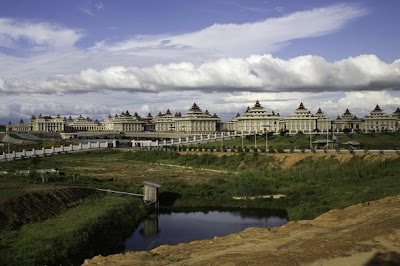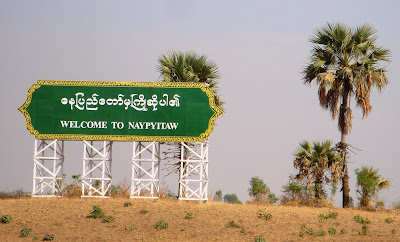ဂ်ပန္လူမ်ဳိး ႏုိင္ငံျခားသား သတင္းစာဆရာတဦးက ျမန္မာႏုိင္ငံ၊ ျမန္မာလူမ်ဳိးတုိ႔ရဲ႕ ဓေလ့စ႐ုိက္၊ ယဥ္ေက်းမႈ၊ လူမႈေရး၊ ႏုိင္ငံေရးအေျပာင္းအလဲ သေဘာသဘာ၀တုိ႔ကုိ ခရီးသြားေဆာင္းပါးမ်ားအျဖစ္ ပုံေဖာ္ထားသည္မွာ စိတ္၀င္စားဖြယ္ေကာင္းလွသည့္အတြက္ မုိးမခစာဖတ္ပရိတ္သတ္ႀကီး ခံစားဖတ္႐ႈႏုိင္ေစရန္အတြက္ မူရင္းဘာသာျပန္သူဆီမွ ခြင့္ေတာင္းၿပီး ျပန္လည္ေဖာ္ျပေပးလုိက္ရပါသည္။
ဂ်ပန္လူမ်ဳိး သတင္းေထာက္ တာကာယူကီ ကာဆူဂါ (Takayuki Kasuga) သည္ မႏွစ္ေႏြရာသီက ျမန္မာျပည္ကိုသြားခဲ့ၿပီးေနာက္၊ ဂ်ပန္ျပည္ အဂၤလိပ္ဘာသာျဖင့္ထုတ္ေ၀ေသာ မုိင္နီခ်ီ ရွင္ဘြန္း (Mainichi Shimbun) သတင္းစာမွာ ခရီးသြားေဆာင္းပါးမ်ား အခန္းဆက္ေရးသားခဲ့ပါသည္။ သူျမင္ေတြ႕ခဲ့ရေသာ ျမန္မာျပည္က ႏုိင္ငံေရး၊ လူမွႈေရး အေျပာင္းအလဲမ်ား၊ ျမန္မာ့ယဥ္ေက်းမႈေနာက္ခံ၊ ျမန္မာလူမ်ဳိးတို႔၏ ဓေလ့စ႐ုိက္မ်ားအေၾကာင္း ဂ်ပန္လူမ်ဳိးတေယာက္၏ အျမင္၊ သတင္းေထာက္တေယာက္၏ ႐ႈ႕ေထာင့္မွ စိတ္၀င္စားဖြယ္ရာ တင္ျပထားသည္မ်ားကို ဘာသာျပန္ေဖာ္ျပလုိက္ပါသည္။
ေနသြင္
ဧၿပီ ၄၊ ၂၀၁၂
• ေနျပည္ေတာ္သုိ႔တေခါက္
စစ္အစိုးရ ႏွစ္ေပါင္းမ်ားစြာအုပ္ခ်ဳပ္ခဲ့တဲ့ ျမန္မာျပည္က စိတ္၀င္စားဖို႔ေကာင္းတဲ့ တုိင္းျပည္ပါ။ အာဏာပုိင္ေတြက အေျပာအဆုိေတြကို ထိန္း ခ်ဳပ္ထားတာ၊ မီဒိယာေတြကို ကန္႔သတ္ထားတာ၊ ႏုိင္ငံျခားသတင္းေထာက္ေတြကိုလည္း ပိတ္ပင္ထားတာေတြေၾကာင့္ သတင္းေလာက မွာလည္း ျမန္မာျပည္အေၾကာင္း အနည္းအပါးေလာက္ပဲ သိၾကပါတယ္။
 အထူးသျဖင့္ ျမန္မာျပည္ရဲ႕ၿမိဳ႕ေတာ္သစ္ ေနျပည္ေတာ္အေၾကာင္းက လွ်ဳိ႕၀ွက္ဆန္းၾကယ္ကိစၥလိုျဖစ္ေနပါတယ္။ ရန္ကုန္ကေန ေနျပည္ ေတာ္ကို ဘာေၾကာင့္ ေကာက္ခါငင္ကာ ေျပာင္းေရႊ႕သြားသလဲဆိုတာကလည္း လူေတြ ေသခ်ာမသိၾကပါဘူး။
အထူးသျဖင့္ ျမန္မာျပည္ရဲ႕ၿမိဳ႕ေတာ္သစ္ ေနျပည္ေတာ္အေၾကာင္းက လွ်ဳိ႕၀ွက္ဆန္းၾကယ္ကိစၥလိုျဖစ္ေနပါတယ္။ ရန္ကုန္ကေန ေနျပည္ ေတာ္ကို ဘာေၾကာင့္ ေကာက္ခါငင္ကာ ေျပာင္းေရႊ႕သြားသလဲဆိုတာကလည္း လူေတြ ေသခ်ာမသိၾကပါဘူး။လြန္ခဲ့တဲ့ေႏြကေတာ့ ျမန္မာျပည္ကို က်ေနာ္ေျခခ်ခြင့္ရပါတယ္။ အစိုးရနဲ႔ အတုိက္အခံ ဒီမုိကေရစီေခါင္းေဆာင္ ေဒၚေအာင္ဆန္းစုၾကည္တို႔ ေတြ႔ဆံုေဆြးေႏြးေနတဲ့အခ်ိန္၊ ျမန္မာျပည္မွာ အေျပာင္းအလဲျဖစ္မယ့္လကၡဏာေတြ ေတြ႔ရတဲ့အခ်ိန္မွာပါ။ တခ်ိန္ကေတာ့ ႏုိင္ငံရဲ႕ၿမိဳ႕ေတာ္၊ အခုေတာ့ အႀကီးဆံုးၿမိဳ႕လို႔ပဲေခၚရေတာ့မယ့္ ရန္ကုန္ၿမိဳ႕ကေန ေျမာက္ဘက္ ကီလိုမီတာ ၃၂၀ ကို ခရီးထြက္ခဲ့ပါတယ္။ ၿမိဳ႕ေတာ္ အသစ္ စက္စက္ေနျပည္ေတာ္ဆီကို ခရီးထြက္ခဲ့တာပါ။
“ေနျပည္ေတာ္မွ ႀကိဳဆိုပါ၏” ဆုိတဲ့ ဆုိင္းဘုတ္ႀကီးကိုျဖတ္သြားၿပီးတဲ့ေနာက္မွာ သက္ကယ္မိုးအိမ္ေတြကို မေတြ႔ရေတာ့ပါဘူး။ အဲဒီအစား ကုန္းျမင့္ျမင့္ေပၚမွာေဆာက္ထားတဲ့ အပ်ံစားအေဆာက္အအံုေတြကို ေတြ႔ရပါတယ္။ ၿမိဳ႕ထဲကို ဆက္၀င္သြားတဲ့အခါမွာ ဟိုတယ္ဇုန္ႀကီး တခုဆီကို ေရာက္သြားပါတယ္။ စိတ္ကူးယဥ္ဆန္ဆန္ေဆာက္ထားတဲ့ ဟိုတယ္ေတြက ဟိုနားဒီနားမွာ ထိုးထိုးမတ္မတ္ မွႈိလိုေပါက္ေနတာ ေတြ႔ရပါတယ္၊။ တခ်ဳိ႕ဟိုတယ္ေတြက ပံုျပင္ထဲက ရဲတုိက္ႀကီးေတြအလား ေအာက္ေမ့ရပါတယ္။
ေနျပည္ေတာ္ေရႊၿမိဳ႕ေတာ္ကို ေတာေတြ၊ ေတာင္ေတြ၊ လယ္ကြင္းေတြကိုရွင္းလင္းၿပီး လွွ်ဳိ႕၀ွက္စြာတည္ေဆာက္ခဲ့တာ ျဖစ္ပါတယ္။ သံတမန္ ေတြၾကားထဲမွာေခတ္စားေနတဲ့ ေကာလဟလကေတာ့ အီရတ္ကို အေမရိကန္တပ္ေတြ၀င္တုိက္ခဲ့တဲ့ ၂၀၀၃ ခုႏွစ္ေလာက္ကစၿပီး ေနျပည္ ေတာ္ကိုတည္ေဆာက္ခဲ့တာလို႔ ဆုိၾကပါတယ္။ ၂၀၀၆ ခုႏွစ္မွာေတာ့ အစိုးရက ၿမိဳ႕ေတာ္ကိုေျပာင္းေရႊ႕ဖို႔ ေၾကညာခဲ့ပါတယ္။
 ျပန္ၾကားေရး၀န္ႀကီးက “ၿမိဳ႕ေတာ္သစ္ဟာ ႏုိင္ငံရဲ႕ဗဟိုခ်က္ေနရာမွာ တည္ရွိတယ္။ ဒါေၾကာင့္ တႏုိင္ငံလံုးနဲ႔ ဆက္သြယ္ေရးလြယ္ကူေစမွာ ျဖစ္တယ္” လို႔ေျပာေပမယ့္၊ အဲဒီမွတ္ခ်က္ကို ဘယ္သူမွ အေလးအနက္မထားၾကပါဘူး။
ျပန္ၾကားေရး၀န္ႀကီးက “ၿမိဳ႕ေတာ္သစ္ဟာ ႏုိင္ငံရဲ႕ဗဟိုခ်က္ေနရာမွာ တည္ရွိတယ္။ ဒါေၾကာင့္ တႏုိင္ငံလံုးနဲ႔ ဆက္သြယ္ေရးလြယ္ကူေစမွာ ျဖစ္တယ္” လို႔ေျပာေပမယ့္၊ အဲဒီမွတ္ခ်က္ကို ဘယ္သူမွ အေလးအနက္မထားၾကပါဘူး။ၿမိဳ႕ေတာ္ကို ေျပာင္းတယ္၊ ေရႊ႕တယ္ဆုိတာက ႏုိင္ငံတနုိင္ငံရဲ႕ မဟာစီမံကိန္းႀကီးတခုပါပဲ။ ဒါေပမယ့္ ၿမိဳ႕ေတာ္ ေျပာင္းေရႊ႕ရတာရဲ႕ ေနာက္ ကြယ္က အေၾကာင္းရင္းမ်ားစြာထဲမွာ “ေဗဒင္အလိုအရ” အရဆိုတာကလည္း တခုအပါအ၀င္ ျဖစ္ပါတယ္။
ျမန္မာျပည္မွာ ဘုရင္ေတြေခတ္ကတည္းက တုိင္းေရးျပည္ေရးမွာ ေဗဒင္ဆရာေတြကလည္း သူ႔ေနရာနဲ႔သူ အသံုးေတာ္ခံခဲ့တာ လူေတာ္ ေတာ္မ်ားမ်ား သိၾကပါတယ္။ အခုအခ်ိန္အထိလည္း ျမန္မာအစိုးရ ထိပ္တန္းေခါင္းေဆာင္ေတြအေပၚမွာ ေဗဒင္ဆရာေတြက တစံုတရာ လႊမ္းမိုးထားပံုပါပဲ။
“ေဗဒင္ဆရာေတြက အေကာင္းဆံုးသတင္းအရင္းအျမစ္ဆုိေတာ့ က်ေနာ္တို႔လည္း သူတို႔ေနာက္ကို အသည္းအသန္လုိက္ခဲ့ရတယ္” လို႔ သံ တမန္တေယာက္က ၀န္ခံပါတယ္။
က်ယ္က်ယ္လြင္လြင္ ေခတ္မီွၿမိဳ႕ေတာ္က အစိမ္းရင့္ရင့္ ထန္းလက္ေတြ၊ တျခားအပင္ေတြကိုေနာက္ခံထားၿပီး တည္ေနပါတယ္။ လွ်ပ္စစ္ ဓာတ္အားေပးလုိင္းေတြကို ေျမေအာက္မွာျမႇဳပ္ထားၿပီး၊ အေဆာက္အဦေတြၾကားထဲက ေျမကြက္လပ္ေတြကလည္း က်ယ္က်ယ္၀န္း၀န္း ရွိ ပါတယ္။ ယာဥ္အသြားအလာလည္း မ်ားမ်ားစားစား မရွိပါဘူး။ ရဲေတြ၊ စစ္သားေတြကိုလည္း သိပ္မေတြ႔ရပါဘူး။ သူတို႔ေတြ အရပ္၀တ္နဲ႔ လူေတြၾကားထဲမွာေရာေနတယ္လို႔ဆုိၾကတာေတာ့ ရွိပါတယ္။
ေနျပည္ေတာ္မွာ ကန္႔သတ္နယ္ေျမေတြကေတာ့ ေတာ္ေတာ္မ်ားမ်ားရွိပါတယ္၊ ႏို္င္ငံျခားသံ႐ုံးေတြကိုလည္း မေတြ႔ရပါဘူး။ ဒါေပမယ့္ စီးပြား ေရးအခ်က္အခ်ာၿမိဳ႕နယ္ေတြမွာေတာ့ လူေတြက လြတ္လြတ္လပ္လပ္ပဲ သြားလာလုပ္ကိုင္ေနၾကပါတယ္။ ဂ်ပန္အလွကုန္ပစၥည္းေတြ၊ ေနာက္ဆုံးေပၚ Flat-screen television ေတြကို အေမရ္ိကန္စတုိင္ shopping mall ေစ်း၀ယ္ကုန္တုိက္ႀကီးထဲမွာေရာင္းခ်ေနတာကို ေတြ႔ရ ပါတယ္။ ႐ုပ္ရွင္႐ုံေတြ၊ ေဂါက္ကြင္းေတြလည္း တခုၿပီးတခု ေပၚလာေနတယ္လို႔ ဆုိၾကပါတယ္။
အစိုးရ႐ုံးေတြနဲ႔ ဆုိင္ခန္းေတြက အေရာင္အေသြးစံု၊ ဆန္းဆန္းျပားျပားနဲ႔ဆုိေတာ့ အပန္းေျဖဥယ်ဥ္ႀကီးလား ေအာက္ေမ့ရပါတယ္။ အသီးအႏွံ ေတြ၊ ဟင္းသီးဟင္းရြက္ေတြေရာင္းတဲ့ေစ်းေတြကိုၾကည့္ရတာလည္း အစိုးရ၀န္ထမ္းေတြအတြက္ ပံ့ပိုးေပးေနရတဲ့ လက္လုပ္လက္စား ျပည္ သူေတြရဲ႕ေန႔စဥ္ဘ၀ သ႐ုပ္သကန္လိုပါပဲ။
ေနျပည္ေတာ္ရဲ႕လူဦးေရက ေသာင္းဂဏန္းကေန အခုဆုိရင္ သန္းခ်ီရွိလာၿပီ။ ေျခာက္ေျခာက္ ကပ္ကပ္ၿမိဳ႕ႀကီးဆုိတဲ့အေနအထားလည္း မဟုတ္ေတာ့ပါဘူး။ အလ်င္အျမန္ေျပာင္းလဲေနတဲ့တခ်ိန္တည္းမွာ ႏုိင္ငံတကာ အားကစားပြဲေတြကိုလက္ခံက်င္းပဖို႔ ရည္ရြယ္ခ်က္နဲ႔ အားက စားကြင္းေတြလည္း ေဆာက္လက္စ ေတြ႕ရပါတယ္။
ေနျပည္ေတာ္ရဲ႕ မဟာအဆန္ဆံုးသ႐ုပ္သကန္ကေတာ့ ပါလီမန္အေဆာက္အံုႀကီးပါပဲ။ ပါလီမန္အေဆာက္ အအံုေရွ႕က လမ္းမႀကီးေဘးမွာ မတ္တပ္ရပ္ရင္း၊ လမ္းေတြကိုလုိက္ေရတြက္ၾကည့္လုိက္ေတာ ၁၈ လမ္း တိတိရွိတာကို တအံ့တၾသ ေတြ႔လုိက္ရပါတယ္။ အ၀င္ ၉ လမ္းနဲ႔ အထြက္ ၉ လမ္းတိတိရွိေနပါတယ္။
မုိင္နီခ်ီ ရွင္ဘြန္းမွာပါတဲ့ မူရင္းေဆာင္းပါးျဖစ္ပါသည္။
Fortune-tellers believed to be behind mysterious relocation of Myanmar’s capital
Takayuki Kasuga
(Mainichi Japan) January 20, 2012
Myanmar, under military rule for many years, is an intriguing country. It is little known by news organizations because authorities controlled speech and the media and shut out foreign journalists. In particular, Naypyidaw, the new capital of Myanmar, is shrouded in mystery, and the reason why the country’s capital was suddenly shifted to the area from Yangon remains unclear.
I stepped into Myanmar in summer last year when dialogue between the government and pro-democracy movement leader Aung San Suu Kyi had got under way, and there are signs that the country is changing.
I traveled north on a 320-kilometer expressway from Yangon, the previous capital which is now called Myanmar’s “largest city,” to the new capital Naypyidaw. After passing a banner saying, “Welcome to Naypyidaw,” houses with thatched roofs were no longer seen. Instead, luxurious mansions were seen standing on hilly areas. As I traveled further into the city, I arrived in a hotel zone, which is dotted with fancy hotels. Some of them look like castles in fairly tales.
Naypyidaw was secretly built by cutting through the jungle and redeveloping farmland. Rumors surfaced among diplomats that a secret city was being built in Myanmar after U.S. forces attacked Iraq in 2003. In 2006 the Myanmar government announced that it had shifted its capital.
“The city is situated at the center of the country and gives easy access to all parts of the country. It’ll be advantageous for developing provincial cities,” said the information minister. However, no one took the comments seriously.
Capital relocation is a major project that can determine the fate of a country. However, one of the widely-presumed reasons behind the relocation is fortune-telling. It is widely known that fortune-tellers have played a certain role in making policies since Myanmar was under the rule of dynasties. Fortune-tellers appear to still have some influence on top officials of the Myanmar government.
“We desperately looked for fortune-tellers as excellent sources of information,” a local diplomatic source admitted.
Bright green leaves of palm trees and other plants stand against the background of the modern spacious city. Electric power cables are buried underground and there are large spaces between buildings. There is not much traffic there. Police officers and soldiers cannot be visibly seen, raising speculation that they are plain-clothed and blend into the crowd.
There are many off-limit military zones in Naypyidaw, and no foreign diplomatic establishments are there. However, people can freely travel in commercial districts, and Japanese cosmetic products and cutting-edge flat-screen television sets are on sale at an American-style shopping mall in the city. Movie theaters and golf courses have reportedly opened one after another in the region.
Official residences for public servants and shops are colorful and fancy and look like theme parks. However, there are areas with many fruit and vegetable stalls that look as if they symbolize the daily lives of ordinary citizens that support government workers’ lives.
Estimates for the population of Naypyidaw vary from as little as tens of thousands to 1 million. However, it has already wiped out its image as an unlively town. The city is undergoing rapid changes and stadiums are under construction with an eye to hosting international sporting events.
The most majestic structure in the capital is the parliament building. I stood by a wide street in front of the building and counted the number of lanes on the road. There were an astonishing 18 lanes — nine inbound lanes and nine outbound lanes. (By Takayuki Kasuga, Foreign News Department)